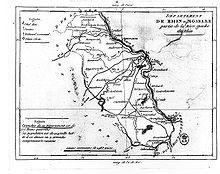Department de Rhin-et-Moselle

The Département de Rhin-et-Moselle (German: Rhein-Mosel-Departement ) was an administrative unit existing from 1798 to 1814 in what is now Rhineland-Palatinate and North Rhine-Westphalia , which was formed in the course of the French Revolutionary Wars on the model of the French departments . It comprised an approximately 40-kilometer-wide strip on the left bank of the Rhine between Bingen and Bonn and consisted of 84 former territories, dominions or larger estates of the imperial knighthood. Essentially, these were the former Electorate of Trier , Electorate of Cologne and Electorate of the Palatinate . The capital of the department with the prefecture was Koblenz . The seat of the prefecture in Koblenz was the von-der-Leyensche Hof am Kastorhof.
history
The Département de Rhin-et-Moselle was established by the First French Republic in 1798 in the territories of the Holy Roman Empire , which had already been conquered after the First Coalition War in 1794 , after the creation of an independent Cisrhenan Republic had failed. The annexation was legalized under international law by the Peace of Lunéville on February 9, 1801. Since the French had to evacuate the areas on the right bank of the Rhine due to the peace treaty, they blew up the old Ehrenbreitstein fortress in the Electorate of Trier .
After the administrative division came into force, the towns and municipalities of the département received civil administration for the first time . From 1802 all monasteries and monasteries in the department were secularized . In the Concordat of 1801, however , the state guaranteed the churches religious tolerance. With the dissolution of ecclesiastical rule and the change in ownership, a new social order emerged. With the adoption of the Civil Code from 1804, a modern legal system was introduced that was based on individual freedoms, equality before the law, adherence to the rule of law, the protection of property and the strict separation of church and state . It continued to apply in the areas on the left bank of the Rhine even after the French period until the introduction of the civil code in 1900. The new legal system replaced the previously usual secret inquisition processes and replaced them with public indictment trials and jury courts . Furthermore, the male population of the conquered areas was used for military service in the French army and thus had to take part in the French wars of conquest, including the Russian campaign , in which many of the soldiers were killed. The French heritage in administration and justice, which was also retained in the Prussian period, allowed there a considerably greater scope for freedom. The Hambach Festival of 1832 and the revolution of 1848/49 would have been unthinkable without this legacy.
The Département de Rhin-et-Moselle existed until 1814. Before that, on New Year's Eve of 1814, Russian troops crossed the Rhine with Blücher's Silesian Army near Koblenz, Kaub and Mannheim . The French vacated the department and left it to the Russians and Prussians without a fight. It was then briefly administered as part of the Generalgouvernement Mittelrhein and finally assigned to the Kingdom of Prussia at the Congress of Vienna in 1815 . Prussia formed the short-lived province of the Grand Duchy of Lower Rhine , the southern forerunner of the Rhine province , from the territories that had fallen to it .
Prefects
The prefects of the department were:
- Philippe Joseph Boucqueau (1800–1803)
- Mouchard de Chaban (1803-1805)
- Alexandre de Lameth (1805-1806)
- Adrien de Lezay-Marnésia (1806-1810)
- Jean Marie Thérèse Doazan (1810-1814)
Administrative units
The department was divided into three arrondissements and initially 30, later 31 cantons :
- Arrondissement de Bonn : Cantons of Adenau , Ahrweiler , Bonn-Stadt, Bonn-Land, Remagen , Rheinbach, Ulmen, Virneburg and Wehr
- Arrondissement de Coblence : Cantons Andernach , Boppard , Coblence, Cochem , Kaisersesch, Lutzerath, Mayen , Münstermaifeld , Polch, Rubenach (Rübenach), Treis and Zell
- Arrondissement de Simmern : Cantons Bacharach , Castellaun (Kastellaun), Kirchberg (Hunsrück), Kirn, Kreuznach, Sankt Goar , Simmern , Sobernheim, Stromberg (Hunsrück) and Trarbach
See also
literature
- Philippe Boucqueau: Mémoire statistique du Département de Rhin-et-Moselle, adressé au Ministre de l'Intérieur. To XII. Archives Nationales, Paris
- Albrecht Friedrich Ludolph Lasius : The French Kayser State under the government of the Kayser Napoleon the Great in 1812 . A historical manual, First Department, Osnabrück bey Johann Gottfried Kißling, 1813, page 394 ( Google Books )
Web links
- Arrêté relatif à la mise en activité de la Constitution dans les départements de la Roer, de la Sarre, de Rhin-et-Moselle et du Mont-Tonnerre (decree bringing the constitution into force in the departments of Roer, Saar, Rhein-Mosel and Donnersberg )
Individual evidence
- ↑ a b Portal Rhenish History at the Rhineland Regional Association Article Rhein-Moseldepartement ( Memento from June 24, 2011 in the Internet Archive )


